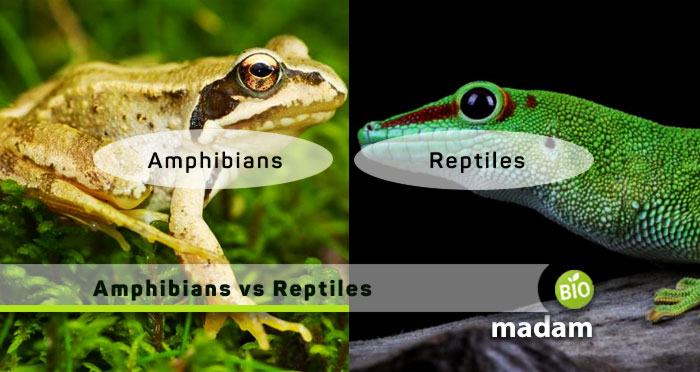Recently updated on October 4th, 2023 at 10:15 am
If you have trouble distinguishing the members of class Amphibian and Reptilia, you are not alone!
Many people find it difficult to identify the two from each other because of structural and habitual similarities. They are among the most alike eukaryotic classes among the five kingdoms. Despite both being vertebrates, a subphylum of chordates, there are numerous differences between amphibians and reptiles that we will discuss in the article. Science enthusiasts would know that the former may live on dry land and in water, whereas the latter prefer land. But did you know that their breathing pattern, skin, and fertilization also differ?
Read further to know everything about reptiles and amphibians, including their structure, physiology, metabolism, defense, classification, etc.
Comparison Table
| Characteristics | Amphibians | Reptiles |
| Definition | Cold-blooded vertebrates that live on land & water | Scaly terrestrial animals |
| History | 370 million years | 312 million years |
| Species | 8,100 | 10,000 |
| Mode of Living | Water and land | Terrestrial |
| Skin | Slimy, moist skin with poisonous secretions | Scaly, dry skin |
| Feet | Webbed feet | Proper four limbs |
| Respiratory System | Gills and lungs | Lungs |
| Heart | 3-chambered | 3-chambered with one ventricle divided into a spectrum |
| Cranial Nerves | Ten pairs | Twelve pairs |
| Fertilization | External | Internal |
| Eggs | Slimy eggs laid in water | Hard shell eggs laid on land |
| Aquatic Larval Stage | Present | Absent |
What are Amphibians?
Amphibians have been living on earth for over 370 million years with over 8100 species. The word Amphibian comes from “amphibious,” meaning “double life” because they live on land and water. However, these characteristics vary in different species and subspecies. Some might live on land only while others dwell in the water.
Amphibians belong to the class Amphibia of cold-blooded vertebrates. They have gills besides lungs that help them breathe in water as well as on land. Gills help them survive in water during their early development. They do not have lungs and proper limbs in the initial developmental stage, which develop later through metamorphosis. Amphibians evolve into terrestrial animals with lungs and four legs.
They have smooth, slimy skin, which enables cutaneous respiration, a type of external respiration. Some organisms lack lungs and rely on this kind of respiratory mechanism. Green rods in their retina allow them to differentiate colors. They also possess a double hearing system.
These animals reproduce through internal or external fertilization. They use particular fragrances as mating calls to mate sexually. They lay eggs in water which are fertilized after being laid as aquatic larvae. This kind of fertilization is known as external fertilization. On the other hand, the embryo develops in the female’s oviduct after internal fertilization. Amphibians are considered the most susceptible organisms in the environment because of their semi-permeable skin.
One common example of Amphibian is the metamorphosis of the frog from a tadpole. Frogs begin their life underwater as tadpoles with gills. They develop lungs at around 14 weeks.
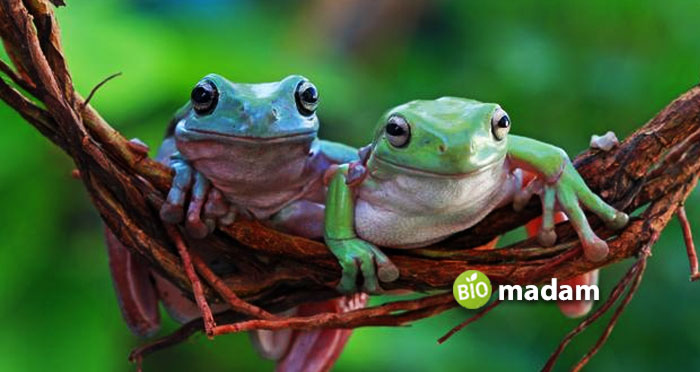
Classification of Amphibians
Amphibians are classified into three orders depending on their structure and appearance, particularly limbs. Here is a detailed insight into each order.
Anura
- Order Anura is also known as Salientia and has around 3400 species from different genera.
- The head and trunk of these organisms are fused.
- They exhibit external fertilization in water.
- Animals in this order have four limbs, and adults do not have a tail.
- Toads and frogs belong to the order Anura.
Caudata
- It is also called Urodela and comprises salamanders and newts.
- They have four limbs and hidden gills.
- These vertebrates possess smooth skin with poisonous glands.
- Animals from this order fertilize internally through spermatogenesis instead of oogenesis.
Apoda
- This order is also widely known as Caecilia or Gymnphiona.
- Amphibians from Apoda are also known as blind worms because of the skin covering their eyes.
- They are limbless animals with scales.
- They also have venom glands in their skin.
- Different epithelial tissues secrete mucus to avoid water loss in amphibians.
Examples of Amphibians
Labyrinthodontia, Caecilians, Frogs, Toads, Salamanders, etc., are examples of amphibians.
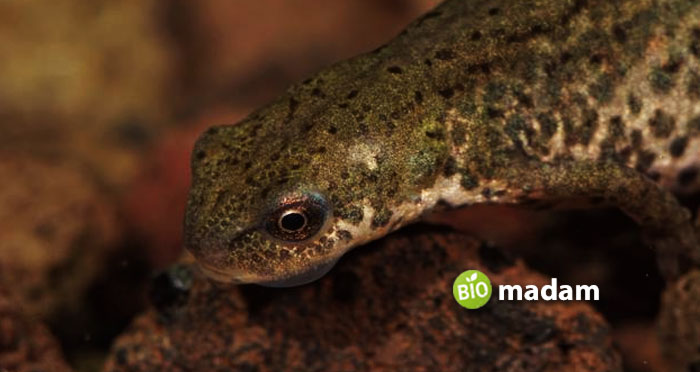
What are Reptiles?
Reptiles are also cold-blood vertebrates belonging to Kingdom Animalia. They have epidermal scales that cover their entire body on the outside. However, their scales are different from fish scales. They are composed of beta-keratin, and their structure and size vary in different species.
Over 10000 reptile species have been living on earth for more than 312 million years. Some reptiles are related more to birds, while others seem closer to amphibians. They possess two pairs of limbs and typically live on the land.
Unlike amphibians, reptiles do not have an aquatic larval stage and gills. Instead, these animals have a developed pulmonary system. They also have advanced visual depth with better color sense. They shed their skin due to metabolic changes in the body.
Reptiles reproduce sexually through internal fertilization. Most reptiles deposit the sperm by copulation, whereas sexual or asexual pathogenesis may occur sometimes. Many members of this class lay amniotic eggs with calcareous shells in nests. Yet, some exceptions, like pythons and boas, give birth to their offspring. The eggs may hatch in a few days or months, depending on the soil temperature. The soil temperature also determines the sex of the young ones.
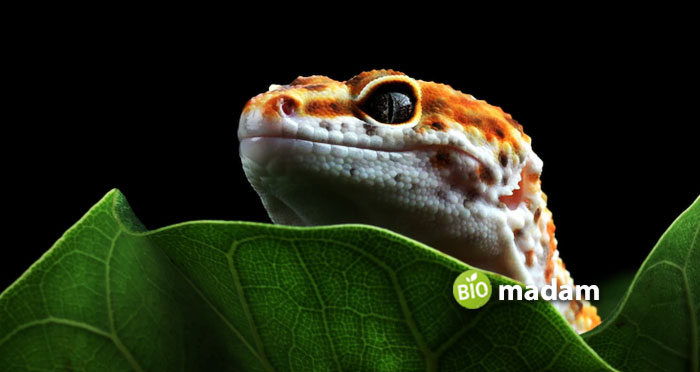
Classification of Reptiles
Reptiles are divided into three major sub-classes and four orders. The three sub-classes are Anapsida, Parapsida, and Diapsida. Moreover, the orders are Squamata, Testudines, Crocodilia, and Sphenodontia. The characteristics of each order are as follows:
Crocodilia
- They have four limbs and may gallop.
- Crocodilian animals have a four-chambered heart.
- They are more intelligent than similar organisms because of their more advanced brain.
- Their bite is quite powerful owing to their strong jaws.
- Alligators, crocodiles, and caimans belong to Crocodilia.
Sphenodontia
- They have a three-chambered heart.
- Sphenodontias are more similar to amphibians than birds.
- They are considered the simplest of all reptiles.
- Tuataras are Sphenodontial organisms.
Squamata
- Order Squamata comprises lizards and snakes of various kinds.
- Lizards have four limbs and a three-chambered heart.
- Some lizards, such as chameleons, change color in stress or danger.
- Snakes do not have legs for locomotion and crawl instead.
- They poison and gulp their prey instantly through their flexible jaw.
Testudines
- A hard shell covers the body of Testudines reptiles.
- They have four legs.
- Tortoises and Terrapins belong to order Testudines.
Examples of Reptiles
Common examples of reptiles include crocodiles, alligators, snakes, tortoises, etc. Apart from the currently existing species, some reptile species have gone extinct. They were more versatile, including Ichthyopterygia, Archosauria, Lepidosauria, and Synapsida.
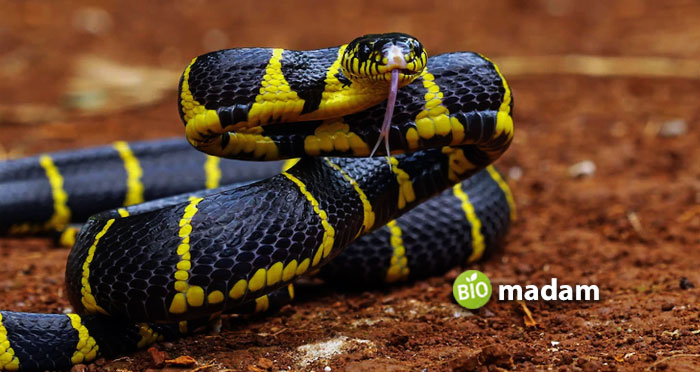
Similarities Between Amphibians and Reptiles
Besides the structural and functional differences between amphibians and reptiles, they are pretty similar as mentioned above. We have put their similarities here in one place for your easy understanding.
- They both belong to Kingdom Animalia.
- They are cold-blooded organisms.
- Reptiles and amphibians are vertebrates.
- You may find them in the same terrestrial areas.
- Both have lungs in some part of life except for a few species.
Difference Between Amphibians and Reptiles
Definition
Amphibians
Amphibians are cold-blooded vertebrates that live on land as well as water to avoid drying their slimy skin.
Reptiles
Reptiles, on the other hand, are a group of cold-blooded terrestrial animals with scales on their bodies.
History
Amphibians
They have existed for over 370 million years now.
Reptiles
Unlike amphibians, the first reptiles were seen over 312 million years ago.
Species
Amphibians
Over 8,100 species of amphibians are known to humankind.
Reptiles
In contrast, researchers have found more than 10,000 species of reptiles to date.
Mode of Living
Amphibians
They are known to have a dual mode of living as they live on land and water both.
Reptiles
On the contrary, they prefer the land and are crawling animals, generally with four limbs.
Skin
Amphibians
Amphibians have slimy and soft skin with mucous glands and toxic secretions. These secretions help them stay safe from predators.
Reptiles
On the other hand, reptile skin is covered by scales of different sizes and structures that vary among species.
Feet
Amphibians
They usually have webbed feet to help them swim.
Reptiles
Conversely, these organisms have properly developed limbs to help them run better.
Respiratory System
Amphibians
Amphibians do not have lungs in early development. Instead, they use gills for breathing underwater, and lungs develop after metamorphosis.
Reptiles
Whereas reptiles have a fully developed respiratory system with lungs to allow them to breathe on land.
Heart
Amphibians
These vertebrates have a 3-chambered heart.
Reptiles
However, their 3-chambered heart has one ventricle divided into a spectrum.
Cranial Nerves
Amphibians
They have ten pairs of cranial nerves.
Reptiles
Alternatively, these organisms have twelve pairs of cranial nerves.
Fertilization
Amphibians
Amphibians typically have external fertilization.
Reptiles
Instead, reptiles exhibit internal fertilization.
Eggs
Amphibians
They lay their eggs in water which are later fertilized.
Reptiles
In contrast, they lay eggs on the land with hard shells.
Aquatic Larval Stage
Amphibians
Amphibians have a larval stage, and the larvae develop into adults through metamorphosis.
Reptiles
On the contrary, reptiles do not exhibit an aquatic larval stage.
The Bottom Line
Reptiles and amphibians are important parts of the ecosystem and community. They are cold-blooded vertebrates belonging to Kingdom Animalia. Besides the similarities like shared habitats in an ecosystem, presence of lungs and close resemblance, there are many differences between amphibians and reptiles. Amphibians have a dual mode of living with an aquatic larval stage and gills while reptiles lack these. They also have dissimilarities in skin, feet, heart chambers, cranial nerves, and fertilization.
FAQs
What are the characteristics of amphibians and reptiles?
Reptiles are characterized by their scaly skin, while amphibians have smooth and slimy skin. The former have four limbs to help gallop, whereas the latter use their webbed feet for swimming.
What is the main difference between amphibians and reptiles?
Their living habits are considered the main difference between the two classes. Amphibians have slimy skin, live on land and in water, and breathe with gills in the larval stage. Contrarily, reptiles have scales and a properly developed breathing system, and mostly stay on the land.
Are frogs reptiles or amphibians?
Frogs are amphibians with a slimy and moist body with webbed feet and stay in water predominantly. They also lay their eggs in water which develop into tadpoles before becoming adult frogs.
Are snakes reptiles or amphibians?
Snakes belong to the class Reptilia because they have scaly bodies. They are among the few reptiles that give birth to their young ones instead of laying eggs.

Hello, I would like to introduce myself to you! I am Chelsea Rogers, an experienced blog writer for science articles, holding an MPhil degree. My enthusiasm to grab the best knowledge, let it relate to botany, zoology, or any other science branch. Read my articles & let me wait for your words s in the comment section.

